Key takeaways:
- Work-life balance is deeply personal and varies for each individual, requiring continuous adjustments based on life circumstances.
- Setting clear boundaries and prioritizing self-care are essential strategies for maintaining balance and preventing burnout.
- Effective time management, including task prioritization and scheduling “me time,” enhances productivity and overall well-being.
- Reflecting on personal priorities and nurturing uplifting relationships can lead to a more fulfilling and balanced life.
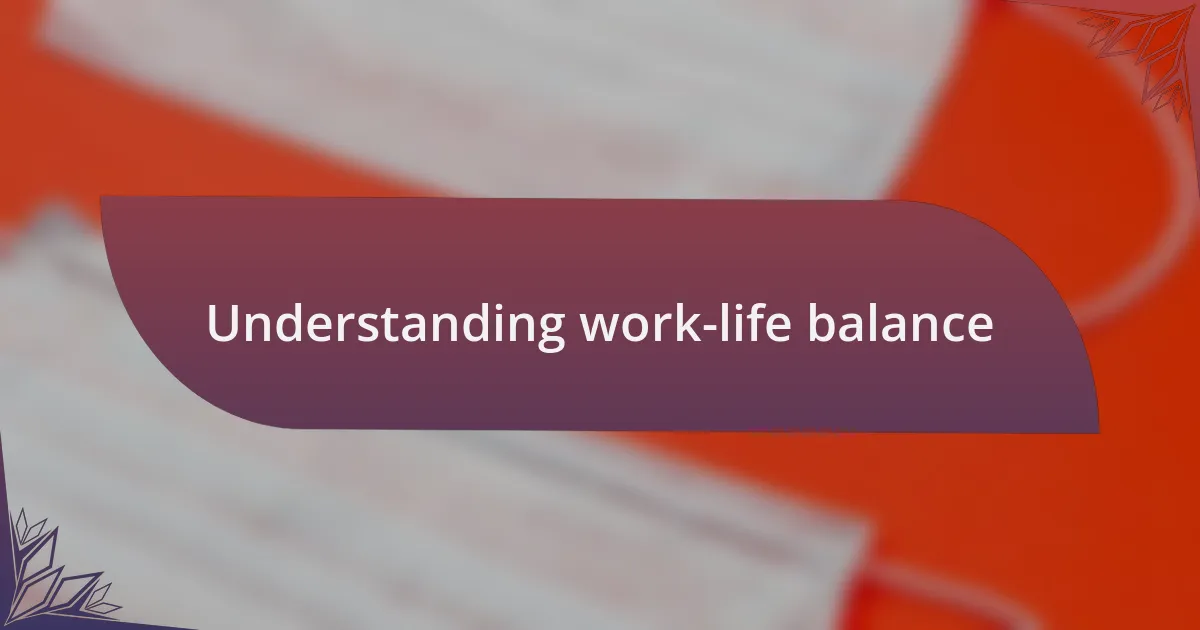
Understanding work-life balance
Understanding work-life balance is essential in today’s fast-paced world. I’ve often found myself pondering, what does it really mean to balance work and life? It’s that dance between responsibilities and desires, where I aim to carve out time for both my career aspirations and my personal joys.
In my experience, achieving this balance is not simply about dividing hours; it’s about valuing quality over quantity. I recall a time when I worked late into the night and missed a family gathering. The guilt lingered long after, reminding me how critical it is to prioritize moments that nourish my spirit. Have you ever felt the weight of similar choices?
Moreover, it’s crucial to acknowledge that work-life balance varies for everyone. One person’s ideal might involve flexible hours, while another thrives in a strict schedule. I’ve learned that this balance is deeply personal, often requiring ongoing adjustments as life unfolds. What strategies do you think might work best for your own unique situation?
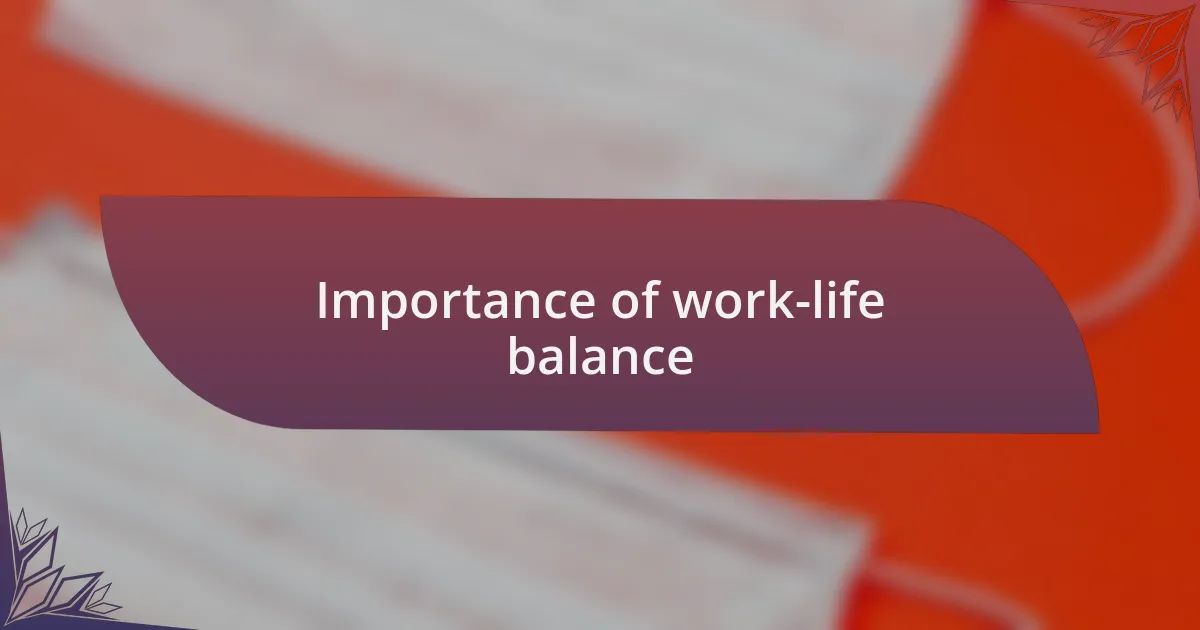
Importance of work-life balance
Work-life balance plays a vital role in maintaining our overall well-being. I remember when I was powering through endless work hours, thinking that was the path to success. However, I realized that my physical health and mental clarity began to fade, reminding me how essential it is to create time for rest and rejuvenation. How often do we overlook our limits in pursuit of productivity?
A significant aspect of work-life balance is its impact on mental health. I once encountered a colleague who was constantly stressed, juggling deadlines and personal commitments. It took a toll on her, and eventually, she crashed from burnout. This experience taught me just how critical it is to set boundaries and ensure that work doesn’t overshadow our personal lives. What steps have you taken to protect your mental health?
Finding a balance also enhances our productivity and creativity. On days when I dedicate time to my hobbies, I often return to my work with renewed energy and fresh ideas. Have you noticed how stepping away for a while can actually boost your effectiveness? It’s a reminder that balancing work with life not only nurtures us but can also improve our professional output significantly.
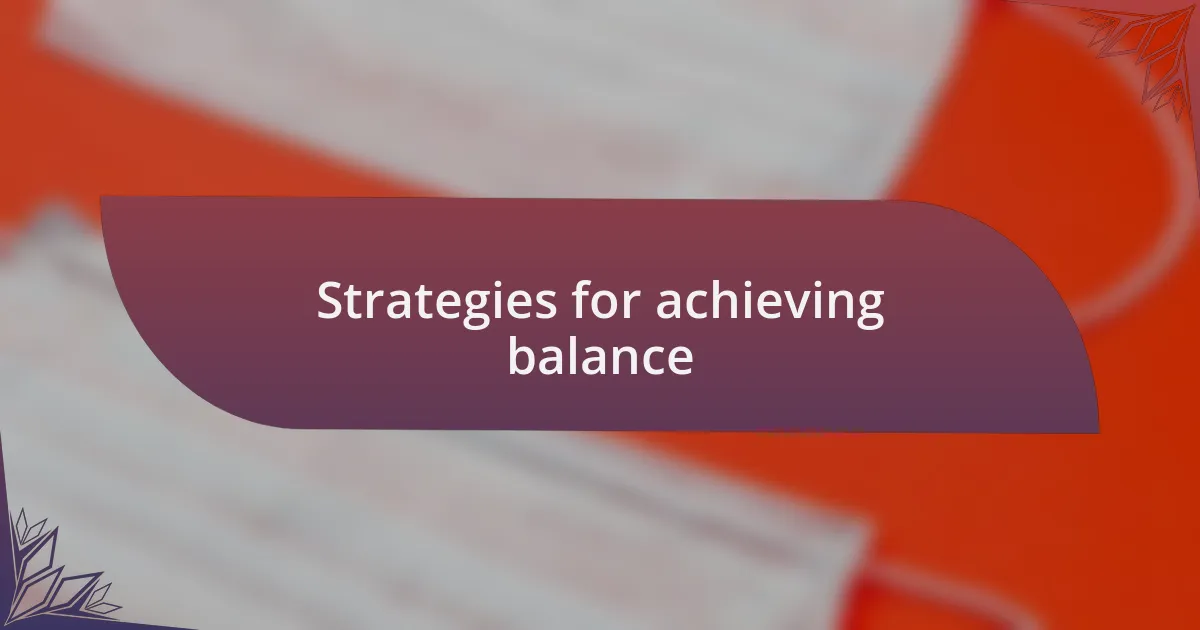
Strategies for achieving balance
One effective strategy I’ve embraced is the practice of setting clear boundaries between work and personal life. I remember when I first started working from home; I found myself checking emails late into the night. Establishing set work hours transformed my routine, allowing me to truly disengage at the end of the day. Do you have a designated time to unwind, or does your work follow you home?
In addition to boundaries, prioritizing self-care has been vital for my balance. I try to carve out at least 30 minutes each day for activities that recharge me, whether it’s a brisk walk or indulging in a good book. There’s something cathartic about stepping away from screens and just being present. How do you reconnect with yourself amidst a busy schedule?
Lastly, I’ve discovered the power of communication in achieving work-life balance. When I openly discuss my workload with colleagues and supervisors, it not only eases my own stress but also encourages a culture of support. I recall a time I voiced my struggles about a heavy project load, and my team rallied together to share the responsibility. Have you considered that sharing your challenges might lead to more effective collaboration?
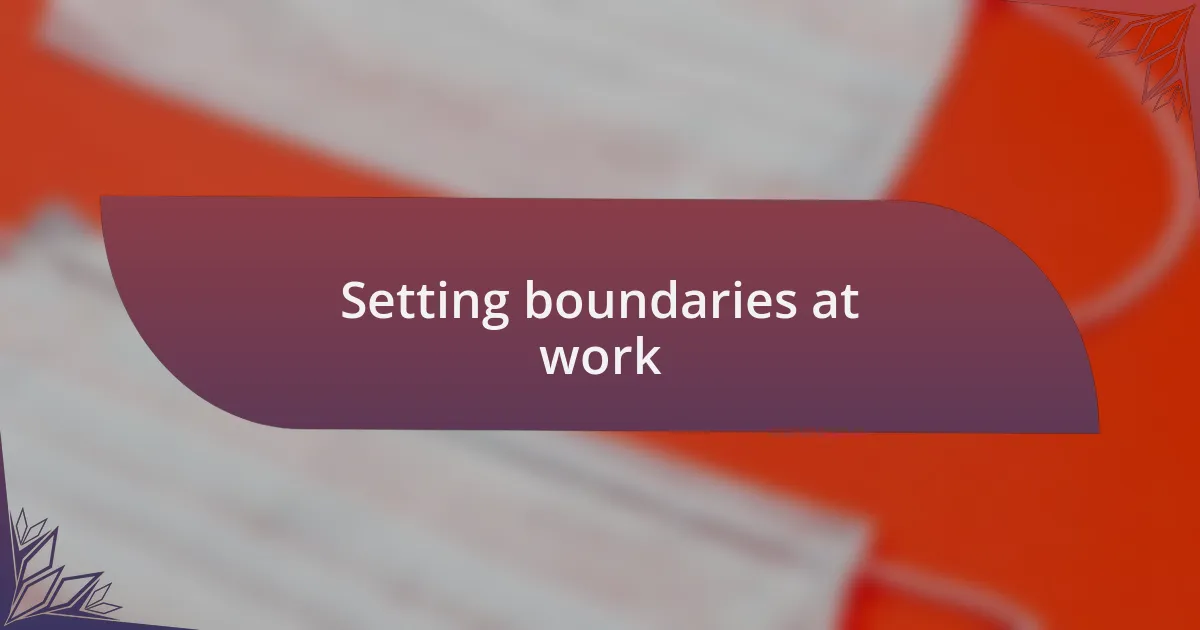
Setting boundaries at work
Setting boundaries at work is something I learned the hard way. I used to believe that being available 24/7 showcased my dedication. Yet, I quickly realized that it drained my energy and affected my personal relationships. By clearly communicating my available hours, I not only preserved my evenings but also found more focus during my work hours. How often do you catch yourself responding to work-related messages after hours?
When I began to say “no” more often, it felt liberating. I recall a time when I was asked to take on an additional project, and after some hesitation, I declined. It wasn’t easy, but setting that boundary allowed me to prioritize my existing tasks and make space for my personal commitments. What would saying “no” look like for you?
I also learned the importance of creating a physical boundary. I established a dedicated workspace at home, distinct from my relaxation areas. This separation makes it easier for me to switch off work mode. When I close my office door at the end of the day, it signals my brain that it’s time to engage with my personal life. Have you thought about how your physical environment affects your work-life balance?
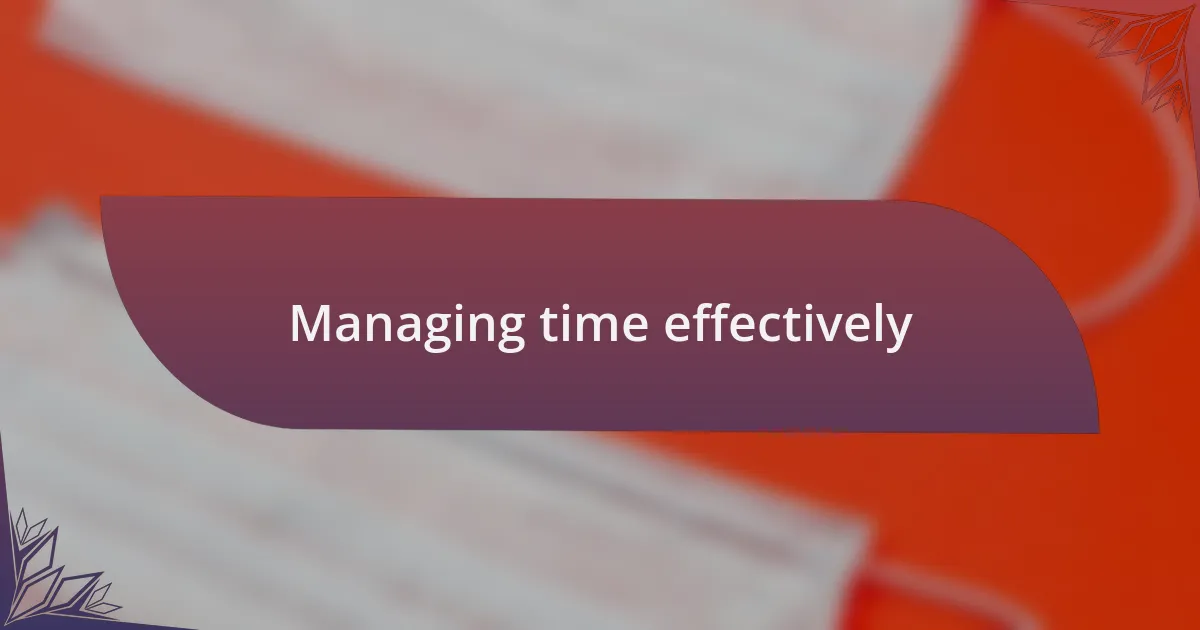
Managing time effectively
Managing time effectively is crucial for maintaining a healthy work-life balance. I remember when I used to over-schedule my days, rushing from one meeting to another without any real breathing room. It not only left me exhausted but also reduced my productivity. Now, I’ve learned to block out time for focused work and short breaks. This approach has transformed my workday; I feel more energized and less overwhelmed. Have you tried structuring your time like this?
When I started prioritizing tasks using a simple to-do list, it felt like a game-changer. I categorize tasks as urgent, important, and those that can wait, which helps me focus on what truly matters. Surprisingly, it also relieved a lot of decision fatigue. Instead of wondering what to tackle next, I have a clear path ahead. Have you ever thought about how prioritization could streamline your day?
Another effective strategy I adopted is scheduling specific “me time” throughout the week. Initially, I felt guilty about dedicating time for myself when there were tasks to complete. But I’ve come to realize that when I invest in my well-being, I can tackle work challenges with renewed vigor. I often ask myself, “What can I do today that will make me feel recharged?” This simple question reminds me that taking breaks isn’t just a luxury; it’s a necessity for sustained productivity. Have you carved out time for yourself lately?
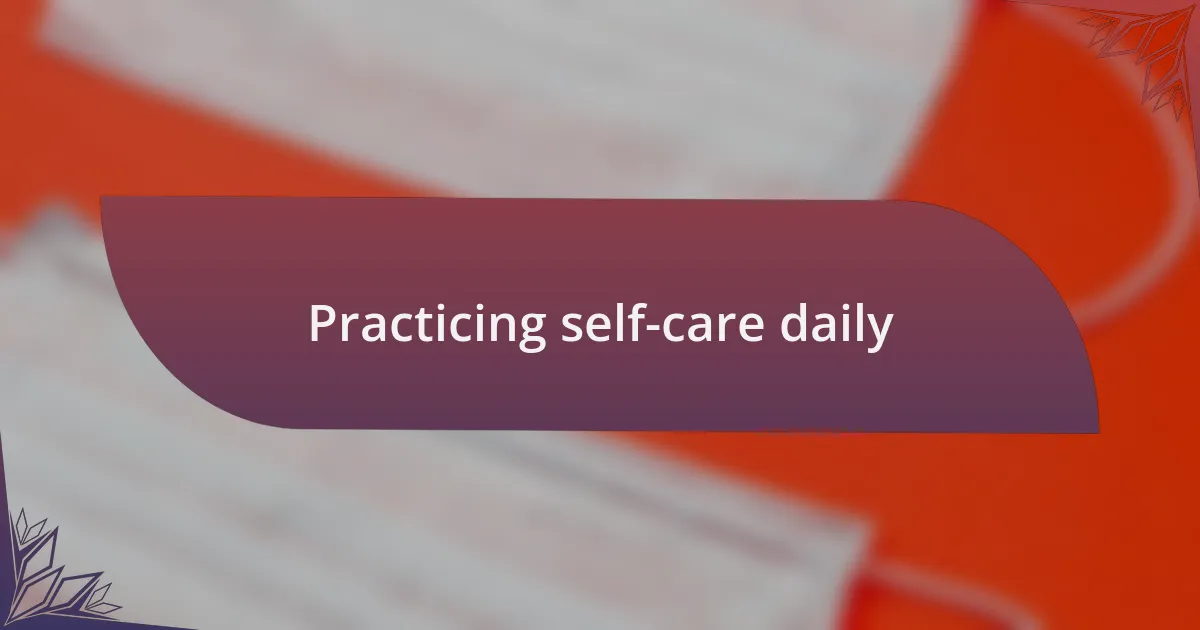
Practicing self-care daily
Practicing self-care daily is essential for my mental and physical well-being. I’ve found that even small acts of self-care, like taking a few minutes each morning to stretch or meditate, set a positive tone for my day. It’s fascinating how such simple routines can provide clarity and calm, allowing me to approach challenges with a clearer mind. How do you greet your mornings?
In the hustle of life, I’ve learned the value of disconnecting before bedtime. For instance, I make it a point to put away my devices an hour before I sleep, which helps me unwind and prepare for restful nights. I cannot stress enough how this simple habit has not only improved my sleep quality but has also enhanced my overall mood the following day. Have you noticed how your sleep is affected by your nighttime habits?
Another practice I cherish is indulging in hobbies that spark joy, whether it’s reading a good book or painting. These activities offer emotional respite, allowing me to escape the pressures of daily life. I remember a night spent lost in a favorite novel, and I woke up the next day brimming with inspiration. What hobbies could you dive into that would lift your spirits?
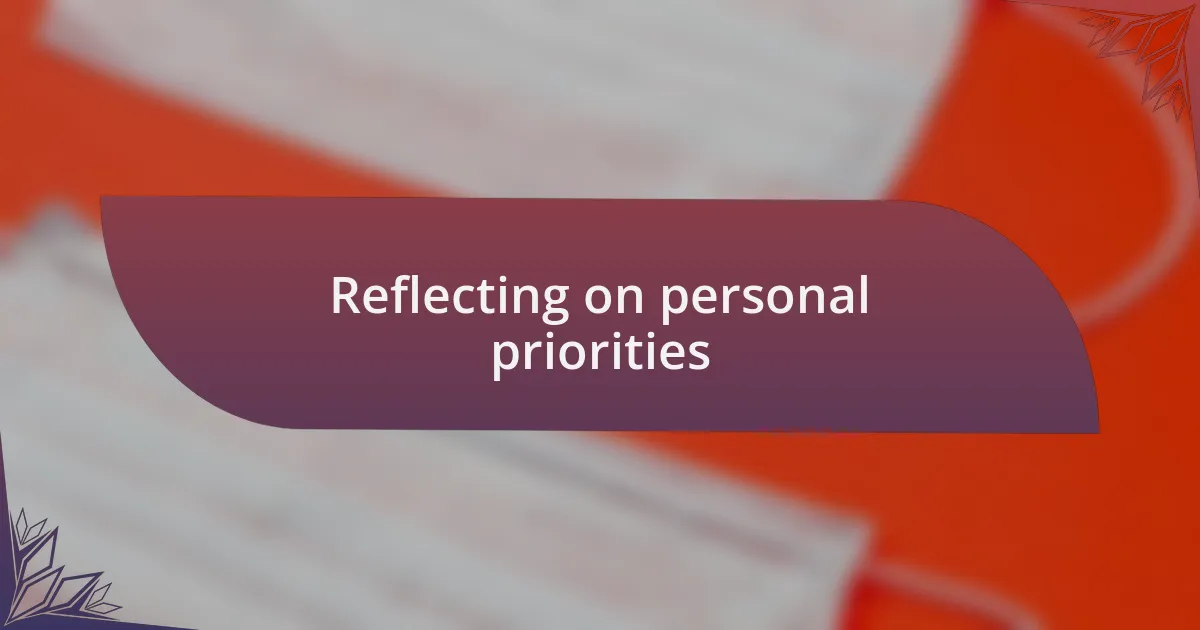
Reflecting on personal priorities
Reflecting on personal priorities requires a moment of introspection. I remember a time when I juggled numerous commitments, but I felt overwhelmed and unfulfilled. I decided to create a list of my top three priorities, and surprisingly, it helped me refocus on what truly mattered in my life. Have you ever tried narrowing down your priorities to see what resonates most with you?
As I delved deeper into my own values, I realized how often I was saying “yes” to tasks that didn’t align with my core beliefs. One weekend, I turned down a social invitation that would have drained my energy for the week ahead. Instead, I focused on a personal project that lit a fire within me. It made me wonder: do your daily activities reflect your true passions, or are you simply going through the motions?
This reflection also forced me to evaluate the relationships in my life. I chose to invest more time in connections that uplift me and support my growth. For instance, I scheduled regular coffee catch-ups with a friend who inspires me, which has been a game changer. It’s interesting how prioritizing the right relationships can transform not just your social life but also your overall mindset. Do you find yourself nurturing the relationships that truly matter to you?